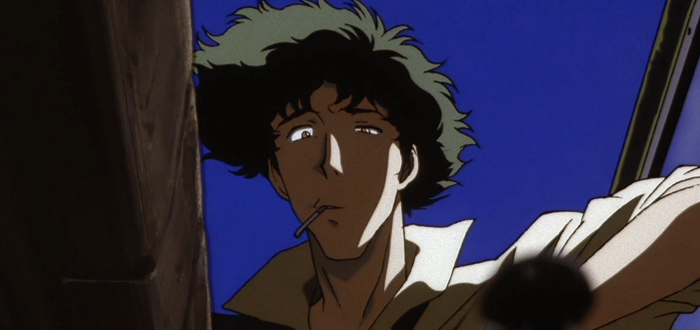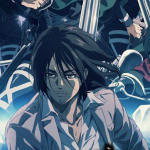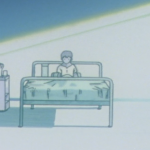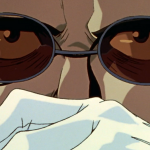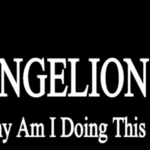Adios, Cowboy: Review 19 – Wild Horses
On this, Cowboy Bebop’s nineteenth outing, I find myself entertaining two thoughts. The first is that Wild Horses is a generally okay episode of Bebop. The second is that I think I’ve learnt all there is to learn from this show.
The episode sees Jet and Faye get into some trouble while trying to catch a clutch of space pirates. At the same time, Spike gets his space fighter, the Swordfish, overhauled on Earth. The overall theme within the episode, as denoted by the title, is about not letting go of things. Kudos to Bebop, however, on shifting the focus to not letting go to objects, primarily space vehicles, from the original intention of the Rolling Stones’ song, not letting go of people. Critic Adam, take us through the first verse and chorus of Wild Horses.
‘Childhood living is easy to do,
The things you wanted I bought them for you,
Graceless lady you know who I am,
You know I can’t let you slide through my hands.Wild horses couldn’t drag me away,
Wild, wild horses couldn’t drag me away…’Hey, Keith Richards, that’s not a healthy relationship at all, man.
Let’s break things down. Spike introduces the episode after apparently crashing in an unnamed desert on Earth. There, the assistant to Spike’s mechanic, Doohan (who is almost certainly a reference to James Dohan, who played Scotty on Star Trek), picks up our favourite bounty hunter and his wreck, hauling them back to Doohan’s shop/scrap yard of 20th century aviation.
Meanwhile in Earth orbit, Faye and Jet are trying to bait a band of space pirates into attacking. The plan seems to work with the pirates hijacking the bait ship and Faye swooping in for a kill shot on their command center. In true Bebop fashion, things go sideways when the pirates harpoon Faye’s ship. The harpoon sends a Cylon style virus into the ship’s “mono-system,” reducing Faye’s ship to a drone for the pirates.
During the course of this space battle, the pirates disparage the Bebop. This is a bigger deal than you might think as it sends Jet into a rage. The quest to continue hunting these pirates, something that might have once been motivated by a bounty, is now a personal matter.
Does anybody else remember when Jet gave Spike a telling off for rushing into battle without thinking? There was that whole history lesson on how Jet got his prosthetic arm. Now Jet is betting his ship against these space pirates because they called the Bebop, an objective pile of junk, a pile of junk. I suppose it works within the framework of this episode, but it’s a stretch within the context of the character and show.
While Jet is defending the honour of his fishing scow turned space ship, Spike is talking about his relationship with the Swordfish as something that is a part of him. When Doohan’s assistant, Miles, asks why he keeps the ship around, Spike says that it is a part of him and he would get rid of it if he could. This nostalgia, or perhaps obsession, is shared with Doohan who spends his spare time retrofitting the space shuttle Columbia. Even Miles shares in this inability to let go via his love of a baseball team that hasn’t been competitive for two decades.
So we have a shared theme between multiple characters in the story’s A-plot. What is it doing? In so far as I can tell, not much. The writing does the work of offering a theme that fits the subtext of the episode’s title, but I don’t see the delivery. Shouldn’t there be a next step beyond showing the consequences of obsession? Because, spoiler alert, everything works out fine for everybody who demonstrates any obsessive qualities in this episode, and they don’t have to change a bit to get their happy ending.
Consider a comparison. In the season 5 episode of Bob’s Burgers, L’il Hard Dad, Bob gets into an RC helicopter war with a local neckbeard. Bob spends the episode cultivating a grudge on principle. His refusal to back down – something his son Gene initially admired in a quest to become a decisive man of action – escalates to Bob dangling from the side of a three-story walk-up. The critical moment of the episode occurs when Gene recognizes that his path to growth comes not through bravado, but through telling his father that he needs to learn to let things go.
The story works because it shows the actions, consequences, and aftermath of tilting at windmills. In that episode, the writing recognizes that it is existing within a closed narrative loop. Therefore, the audience needs to see conflict and outcomes within the span of the single story. That resolution and growth is what’s missing from this episode. And I have to say it is really starting to chap my ass that Bebop regularly fails to deliver on that point. Particularly when this series is coming from a director who insists on framing each episode of Bebop as if it were a film. Films have structure. Films do things. Even films based on Cormac McCarthy novels move their characters and audience from one place to another by the time they end. Yes, even No Country for Old Men.
Bebop wants to be all things at once. The laughs of a sitcom paired with the freedom of the art house. Throw in a dash of serialized TV for good measure. But there’s a saying I learnt back in the 8th grade: trying to be everything accomplishes nothing. The last three episodes have been nothing if not stand-alone episodes; or if they are not stand-alone episodes then their connectivity to the rest of the story is not immediately evident. For my time, that places a burden on the writing to show some sort of unit-level growth. I am not seeing it.
What we’re getting in Wild Horses is a cool concept that only works because of the strength of its visual execution. The episode lives for the thrill of watching Doohan pilot the Columbia such that Spike, once again out of gas and facing imminent death, can be captured in the Columbia’s cargo hold rather than burn up in the Earth’s atmosphere. Then, just to take the edge off the obvious deus ex machina, Doohan says that the Columbia’s heat tiles have all peeled off and the landing gear won’t come down.
Remember, 1998, the Columbia disaster hadn’t happened yet.
The final scene presents a slow pan across Doohan’s photo wall. It comes to a stop on Spike, Doohan, and Miles sitting in front of a crashed but recognizable Columbia. What have they learnt? Where have the grown? Who knows. We will probably never get the answers to those questions. Pair that with the last few episodes following the Star Trek formula of hitting the reset button on the episode’s events, and the audience is denied even the minor satisfaction of seeing how they will solve the practical problems of this episode: to wit, how will Spike pay for two sets of repairs on the Swordfish?
This is why this episode, and arguably the last few episodes haven’t landed for me. It is well and good to do inter-connected episodes. Likewise, I have no problem with stand-alone episodes. But stand-alones require telling 100% of a story in a short span. Bebop needs to show the change. I would go so far as to say that the onus on it showing the change is greater now than it was back with Asteroid Blues. Back then we knew so little about the characters that minor shifts in their behavior could feel like a greater moment of growth.
Thus we come to the writing lesson for the episode. Any entry-level dumb-dumb can build character eccentricities around a theme and have it come off as okay in the eye of the audience. The real challenge comes in showing growth for familiar characters with a limited span. This episode tries to do this with dialogue, rather than actions, and comes up feeling short. It’s not a bad episode, but it’s one more that shows how a person might learn from Cowboy Bebop’s failings and not its strengths.

